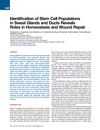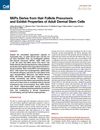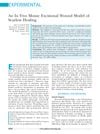Cutaneous Scarring: Basic Science, Current Treatments, and Future Directions
August 2016
in “
Advances in wound care
”

TLDR New effective scar treatments are urgently needed due to the current options' limited success.
The document from 2018 reviews the science behind cutaneous scarring, the roles of various cells and growth factors in wound healing, and the current and potential future treatments for scars. It explains that scarring can have significant functional and psychological impacts, particularly in children, and that despite understanding the cellular and molecular mechanisms involved, effective treatments to prevent or reduce scarring are still lacking. The document highlights the importance of stem cells in skin regeneration and hair follicle formation, and the potential of targeting specific fibroblast populations and signaling pathways, such as TGF-ß, to develop new therapies. Current treatments, including surgical options, corticosteroid injections, laser therapy, and pressure garments, are not fully effective in preventing scarring. Novel treatments like Metelimumab and Imatinib mesylate have not shown promising results in clinical trials. The document concludes that there is a pressing need for new therapies to address the high prevalence and psychological impact of scarring.










